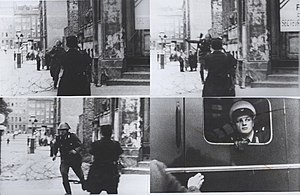Konrad Schumann
This article needs additional citations for verification. (August 2014) |
Konrad Schumann | |
|---|---|
 Konrad Schumann leaping over barbed wire into West Berlin on 15 August 1961. 52°32′20″N 13°23′56″E / 52.5390°N 13.3990°E | |
| Born | Hans Konrad Schumann March 28, 1942 |
| Died | June 20, 1998 (aged 56) Kipfenberg, Oberbayern, Germany |
| Nationality | German |
| Occupations |
|
| Known for | Defecting from East to West Berlin in 1961. |
| Spouse |
Kunigunde Schumann (m. 1962) |
| Children | Erwin Schumann (son) |
Hans Konrad Schumann (March 28, 1942 – June 20, 1998) was an East German border guard who escaped to West Germany during the construction of the Berlin Wall in 1961.
Early life
Born in Zschochau (now part of Ostrau, Saxony) during World War II, Schumann enlisted in the East German Bereitschaftspolizei (state police) following his 18th birthday. After three months' training in Dresden, he was posted to a non-commissioned officers' college in Potsdam, after which he volunteered for service in Berlin.
Escape to West Germany
On 15 August 1961, the 19-year-old Schumann was sent to the corner of Ruppiner Strasse and Bernauer Strasse to guard the Berlin Wall on its third day of construction. At that time and place, the wall was only a single coil of concertina wire. From the other side, West Germans shouted to him, "Komm' rüber!" ("Come over!"), and a police car pulled up to wait for him.
Schumann jumped over the barbed wire while dropping his PPSh-41 submachine gun and was promptly driven away from the scene by the West Berlin police. West German photographer Peter Leibing photographed Schumann's escape. This photograph, entitled "Leap into Freedom", has since become an iconic image of the Cold War era and featured at the beginning of the 1982 Disney film Night Crossing. The scene, including Schumann's preparations, was also filmed on 16-mm film from the same perspective by camera man Dieter Hoffmann.[1]
Schumann went from West Berlin into West Germany, where he settled in Bavaria. In 1962, he met and married Kunigunde Gunda in Günzburg. They had a son the next year.[2] He took up a new job at a winery and eventually at the Audi car assembly factory in Ingolstadt, where he worked for nearly 30 years.
Later life and death

After the fall of the Berlin Wall Schumann said, "Only since 9 November 1989 [the date of the fall] have I felt truly free." Even so, he continued to feel more at home in Bavaria than in his birthplace, citing old frictions with his former colleagues, and was even hesitant to visit his parents and siblings in Saxony.
On 20 June 1998, suffering from depression, he committed suicide, hanging himself in his orchard near the town of Kipfenberg in Upper Bavaria. His body was found by his wife a few hours later.[3]
In May 2011, the photograph of Schumann's "leap into freedom" was inducted into the UNESCO Memory of the World programme as part of a collection of documents on the fall of the Berlin Wall.[4][5]
Monument

A sculpture called Mauerspringer ("Walljumper") by Florian and Michael Brauer and Edward Anders can be seen close to the site of the defection,[6] but has since been moved to the side of a building on Brunnenstraße, several meters south of Bernauer Straße.
Literature
- Christoph Links: Schumann, Konrad. In: Wer war wer in der DDR? 5. Ausgabe. Band 2, Ch. Links, Berlin 2010, ISBN 978-3-86153-561-4.
See also
References
- ^ "Sprung in die Freiheit". Programm.ARD.de – ARD Play-Out-Center Potsdam, Potsdam, Germany. Retrieved January 23, 2020.
- ^ "KONRAD SCHUMANN, 56, SYMBOL OF E. BERLIN ESCAPES". Chicago Tribune (NORTH SPORTS FINAL ed.). Associated Press. June 23, 1998. p. 8.
- ^ DENIS STAUNTON (Jun 22, 1998). "Escaped soldier found hanged". The Guardian. Manchester (UK). p. K2.
- ^ Diekmann, Kai. Die Mauer. Fakten, Bilder, Schicksale. München: Piper, 2011 (ISBN 978-3-492-05485-0), p. 45
- ^ German Commission for UNESCO, World Documentary Heritage in Germany
- ^ "Pictures of the day: 30 July 2009". The Telegraph. UK. Jul 30, 2009.
External links
 Media related to Conrad Schumann at Wikimedia Commons
Media related to Conrad Schumann at Wikimedia Commons
- 1942 births
- 1998 deaths
- German military personnel who committed suicide
- People from Riesa
- Suicides by hanging in Germany
- East German defectors
- Berlin Wall
- Black-and-white photographs
- National People's Army personnel
- East German emigrants to West Germany
- People notable for being the subject of a specific photograph
- 1961 works
- 1961 in art
- 1960s photographs

